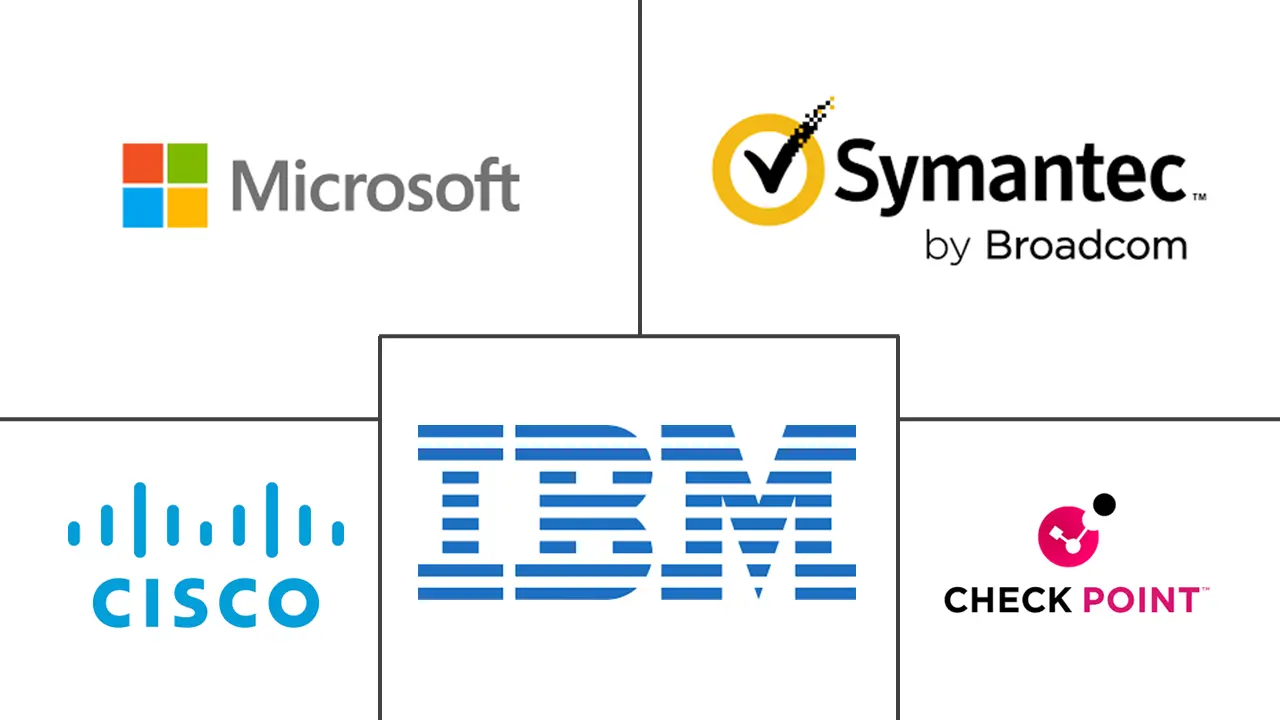Cybersecurity Software Market Size and Share

Cybersecurity Software Market Analysis by Mordor Intelligence
The cybersecurity software market reached USD 141.13 billion in 2025 and is projected to climb to USD 265.99 billion by 2030, advancing at a 13.51% CAGR. Cloud-first mandates, rising adoption of zero-trust frameworks, and the growing volume of AI-enabled attacks are reinforcing demand for unified security platforms. Cloud deployment models already command two-thirds of total spending, while platform consolidation continues as enterprises reduce tool sprawl and seek measurable risk reduction. Escalating regulatory fines and incident-disclosure rules are accelerating procurement decisions, and proactive investment is spreading from large enterprises to small and medium businesses. Vendors that integrate identity, cloud, and analytics functions into a single architecture are capturing outsized opportunity within the cybersecurity software market.
Key Report Takeaways
- By offering, Identity and Access Management led with 25.5% revenue share in 2024; cloud security is forecast to expand at a 14.9% CAGR through 2030.
- By deployment model, cloud deployments held 67.4% of the cybersecurity software market share in 2024 and are projected to grow at 13.9% CAGR to 2030.
- By end-user vertical, Banking, Financial Services, and Insurance accounted for 27.3% of the cybersecurity software market size in 2024, whereas healthcare is advancing at a 13.7% CAGR through 2030.
- By organization size, large enterprises accounted 63.7% of market size in 2024, while the SME segment is poised for the quickest expansion at 14.2% CAGR.
- By geography, North America remained the largest regional market in 2024 accounting 24.6%; Asia-Pacific is set to post the fastest growth at 13.5% CAGR through 2030.
Global Cybersecurity Software Market Trends and Insights
Drivers Impact Analysis
| Driver | (~) % Impact on CAGR Forecast | Geographic Relevance | Impact Timeline |
|---|---|---|---|
| Cloud-first adoption and zero-trust mandates | +2.80% | Global, with North America and EU leading | Medium term (2-4 years) |
| Surge in AI-driven, multi-vector cyber-attacks | +3.20% | Global, with Asia-Pacific experiencing 31% of attacks | Short term (≤ 2 years) |
| Expanding regulatory fines (e.g., SEC incident-disclosure) | +1.90% | North America and EU primarily | Medium term (2-4 years) |
| Shift to API-centric architectures (new attack surface) | +2.10% | Global, concentrated in tech hubs | Short term (≤ 2 years) |
| OT/IT convergence in critical infrastructure | +1.70% | Global, with manufacturing-heavy regions | Long term (≥ 4 years) |
| Rising cyber-insurance premiums drive proactive security | +1.40% | North America, expanding to Asia-Pacific | Medium term (2-4 years) |
| Source: Mordor Intelligence | |||
Cloud-first Adoption and Zero-trust Mandates
Zero-trust frameworks are moving from strategic vision to operational reality, with 81% of organizations planning deployments by 2026. Major providers now embed security-by-design into cloud services, and Microsoft’s cybersecurity revenue surpassed USD 20 billion in 2024, underscoring vendor momentum. Analysts confirm that 68% of recent industrial incidents started with IT system compromise, tightening the link between zero-trust projects and operational resilience. Multicloud complexity is prompting enterprises to favor unified policy enforcement across environments, which is driving up demand for integrated platforms. Providers that combine identity, access, and network segmentation within a single stack are gaining procurement preference. The result is a steady uptick in long-term contracts that lock in platform subscriptions.
Surge in AI-driven, Multi-vector Cyber-attacks
Information-stealing malware cases spiked 500% in 2024, while ransomware-as-a-service shops lowered entry barriers for attackers.[1]Fortinet, “Global Threat Landscape Report 2024,” fortinet.com API vulnerabilities rose 1,205% as adversaries automated reconnaissance and exploitation, overwhelming traditional defenses. The high-profile Change Healthcare breach affected 100 million people and involved a USD 22 million ransom payment, demonstrating the business impact of AI-enabled campaigns. CrowdStrike now processes 84 trillion daily threat signals to sharpen predictive analytics, reflecting escalating arms-race dynamics. Boards increasingly treat AI-driven risk as a strategic threat, translating into budget protection even amid broader IT spending reviews.
Expanding Regulatory Fines and SEC Incident-disclosure
Mandatory disclosure of material cyber incidents within four business days, introduced by the U.S. Securities and Exchange Commission in 2024, has raised the visibility of cybersecurity risk at board level. NIST’s Cybersecurity Framework 2.0 added a new govern function, linking cyber controls to enterprise risk management for all sectors.[2]National Institute of Standards and Technology, “NIST Cybersecurity Framework 2.0,” nist.gov European NIS2 rules similarly push businesses to prove robust defenses or face penalties, and healthcare breach costs now average USD 9.77 million, reinforcing urgency. Compliance spending is therefore converting from discretionary to non-discretionary, underpinning sustained purchasing even in cautious macro climates. Vendors that supply automated evidence collection, board-ready reporting, and control mapping see accelerated deal cycles.
Modern applications expose hundreds of ephemeral APIs, many of which are neither cataloged nor monitored. Attackers exploit these blind spots using machine-generated traffic that traditional firewalls fail to detect. Samsung’s patent filings for AI-driven traffic inspection on 5G and 6G networks point to an even broader API surface looming at the edge Financial-services and healthcare firms, which depend on rapid digital transformation, face especially high exposure. As a result, demand for real-time API discovery and threat prevention platforms is outpacing growth in legacy web-application firewalls. Security budgets are being reprioritized toward API runtime protection and posture management.
Restraints Impact Analysis
| Restraint | (~) % Impact on CAGR Forecast | Geographic Relevance | Impact Timeline |
|---|---|---|---|
| Persistent talent deficit and wage inflation | -2.10% | Global, acute in North America and EU | Long term (≥ 4 years) |
| Tool sprawl causing ROI fatigue in C-suites | -1.80% | North America and EU primarily | Medium term (2-4 years) |
| Legacy technical debt in public sector and SMBs | -1.30% | Global, concentrated in emerging markets | Long term (≥ 4 years) |
| Sovereign-cloud and data-residency conflicts | -0.90% | EU, Asia-Pacific with data localization laws | Medium term (2-4 years) |
| Source: Mordor Intelligence | |||
Persistent Talent Deficit and Wage Inflation
Japan alone needs over 200,000 additional cybersecurity professionals, and specialists there earn about USD 135.50 per hour, up from prior levels.[3]Nucamp, “Japan Cybersecurity Workforce Gap,” nucamp.co Operational-technology security skills are scarcer still, even as OT attacks rose 73% in 2024. Companies are shifting to managed security services and to AI-based automation to fill gaps, but both require cultural change and onboarding investments. The shortfall increases the total cost of ownership for advanced security programs and slows large-scale rollouts. Over time, persistent wage pressure will influence vendor pricing models and could moderate the cybersecurity software market growth rate.
Tool Sprawl Causing ROI Fatigue in C-suites
Many enterprises manage 50 or more discrete security tools, yet breaches persist, leading executives to question incremental spending. CrowdStrike’s consolidation strategy shows traction, with 64% of customers now running five or more modules on its platform. Cybersecurity M&A rocketed to USD 6 billion during the first five months of 2024 versus USD 852 million a year earlier, underscoring industry recognition that scale and simplicity matter. Boards now measure success by outcome metrics such as dwell time and mean-time-to-contain rather than by count of deployed tools. Vendors lacking integration depth risk displacement despite technically strong point capabilities.
Segment Analysis
By Offering: Identity Leadership and Cloud Security Momentum
Identity and Access Management commanded 25.5% of the cybersecurity software market share in 2024, illustrating that identity is now the primary control plane for enterprise defense. Cloud security solutions are forecast to register a 14.9% CAGR through 2030, the fastest of all offerings, as businesses secure multicloud and hybrid workloads. CyberArk’s USD 1.54 billion acquisition of Venafi spotlights the growing importance of machine-identity governance. The cybersecurity software market size tied to application and data security is also rising as DevSecOps gains ground and privacy regulations tighten.
Demand is coalescing around integrated platforms that span identity, cloud, data, and infrastructure layers. Infrastructure and network protection remains core for hybrid environments, while emerging post-quantum cryptography solutions move from labs to pilots after NIST finalized three quantum-resistant algorithms in 2024. Customers increasingly prefer vendors that can knit multiple functions into a single control fabric to lower operational overhead.
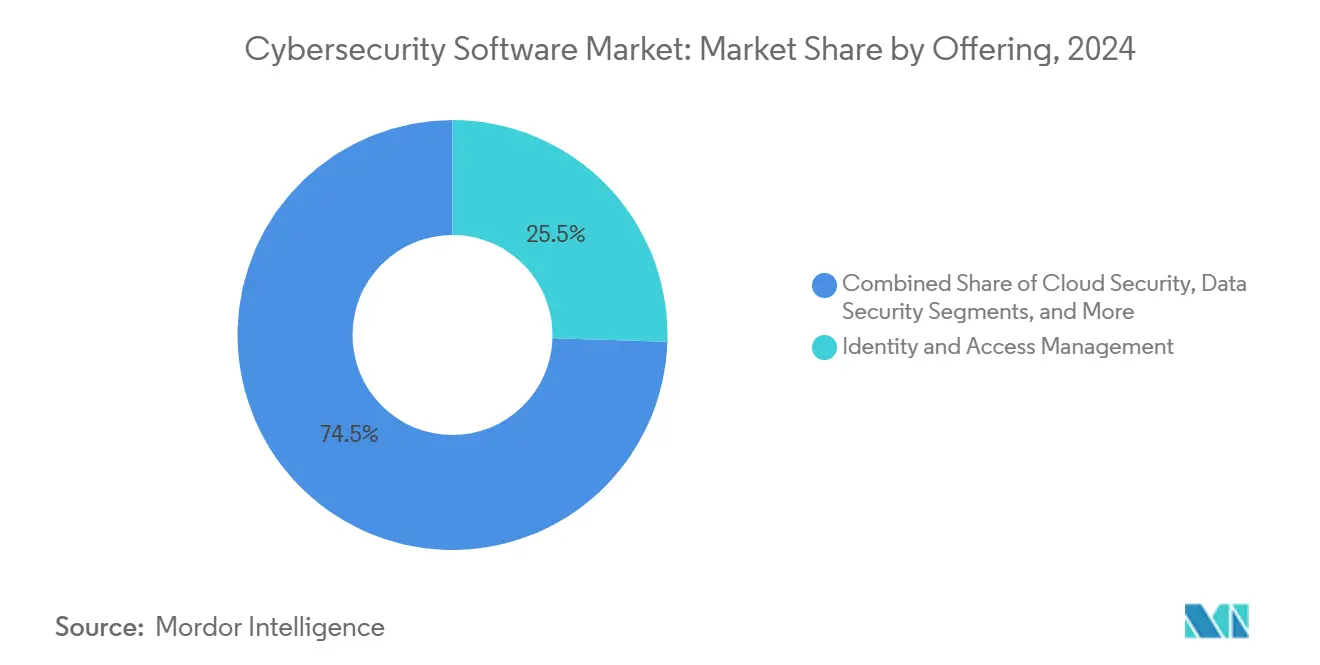
Note: Segment shares of all individual segments available upon report purchase
By Deployment Model: Cloud Extends Dominance
Cloud deployments captured 67.4% share in 2024 and are expected to grow at 13.9% CAGR through 2030, cementing irreversible migration trends in the cybersecurity software market. Microsoft enhanced Azure with AI threat analytics and post-quantum encryption, showing how hyperscalers embed advanced capabilities directly into their stacks. On-premises implementations decline steadily yet persist where regulatory data-residency rules apply.
Hybrid strategies combine cloud agility with on-site controls for sensitive workloads such as patient data. Healthcare organizations moved decisively to cloud security after seeing a 300% jump in attacks since 2015. Edge computing is emerging as a third pillar requiring location-aware policy enforcement. Vendors able to protect workloads consistently across cloud, on-premises, and edge win favor in procurement cycles.
By End-User Vertical: Healthcare Accelerates
BFSI institutions held 27.3% of 2024 spending thanks to mature risk practices and stringent oversight. Healthcare exhibits the fastest CAGR at 13.7% as breach costs top USD 9.77 million and ransomware hits critical patient services. The cybersecurity software market size attached to manufacturing also rises as OT/IT convergence exposes factories to digital sabotage.
Government agencies prioritize supply-chain visibility, while telecom carriers harden networks against nation-state intrusions. Renewable-energy projects and smart-city pilots, grouped under “Others,” demand specialized situational-awareness tools. Cross-industry priorities include secure software supply chains and automated compliance reporting to regulators.
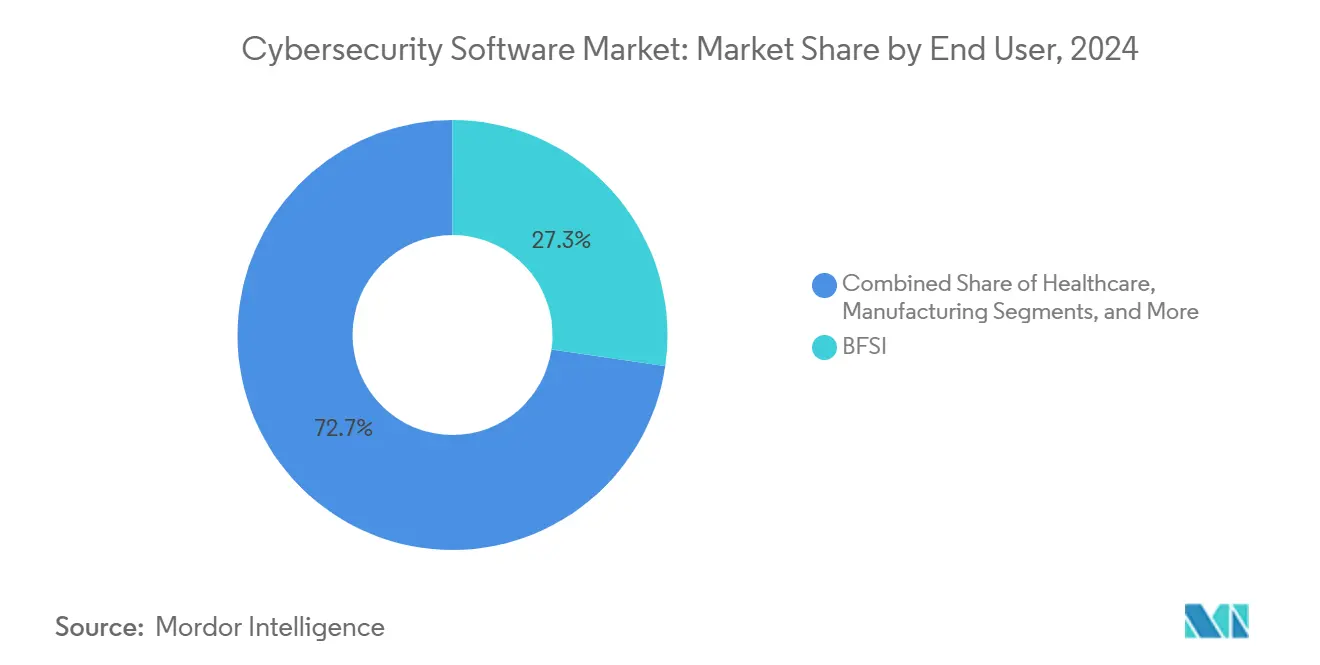
Note: Segment shares of all individual segments available upon report purchase
By Organization Size: SME Opportunity Expands
Large enterprises still account for 63.7% of market share in 2024, but SMEs will post the highest 14.2% CAGR through 2030. Sixty percent of startups could shut within six months of a severe breach, which elevates security from optional to existential for smaller firms. Cloud-native platforms simplify administration, allowing SMEs to deploy advanced controls without deep expertise.
Managed security providers supply outsourced detection and response, bridging talent gaps. Attackers increasingly exploit SME partners to pivot into larger enterprises, as seen in the Blue Yonder ransomware chain that disrupted major retailers. Vendors offering right-sized subscription models and automated onboarding will capture growing share within the cybersecurity software market.
Geography Analysis
North America accounts of 24.6% the largest regional share through a mature vendor ecosystem, strong venture funding, and regulatory mandates such as SEC incident-disclosure rules. Microsoft’s security revenue surpassed USD 20 billion, and CrowdStrike reported USD 4.6 billion annual recurring revenue in 2025, showcasing regional scale. Cross-border supply-chain requirements are boosting adoption in Canada and Mexico. Cyber-insurance premiums have stabilized, suggesting improving baseline defenses across enterprises.
Asia-Pacific is the fastest-growing region with a 13.5% CAGR through 2030, driven by rapid digitization and elevated threat volume that accounts for 31% of global incidents. China’s cybersecurity outlays are projected to top USD 38.6 billion by 2023, propelled by government directives. Japan expects a USD 13.25 billion market by 2029 but faces significant talent shortages. South Korea nurtures innovative startups like AI SPERA, which raised USD 8.5 million to scale its Criminal IP platform. The region’s cyber-insurance premiums are growing near 50% annually, signaling maturation of risk-transfer mechanism.
Europe shows steady expansion under GDPR, NIS2, and emerging AI regulations requiring demonstrable controls. Germany, the United Kingdom, and France lead spending, while Eastern European states accelerate adoption amid EU integration. The Middle East and Africa exhibit high-growth pockets, led by Gulf Cooperation Council smart-city projects and national cyber strategies in the UAE and Saudi Arabia. South Africa, Nigeria, and Egypt are early continental leaders, though workforce development remains a constraint. Vendors that localize offerings to data-sovereignty rules and language preferences stand to gain within these emerging sub-regions.
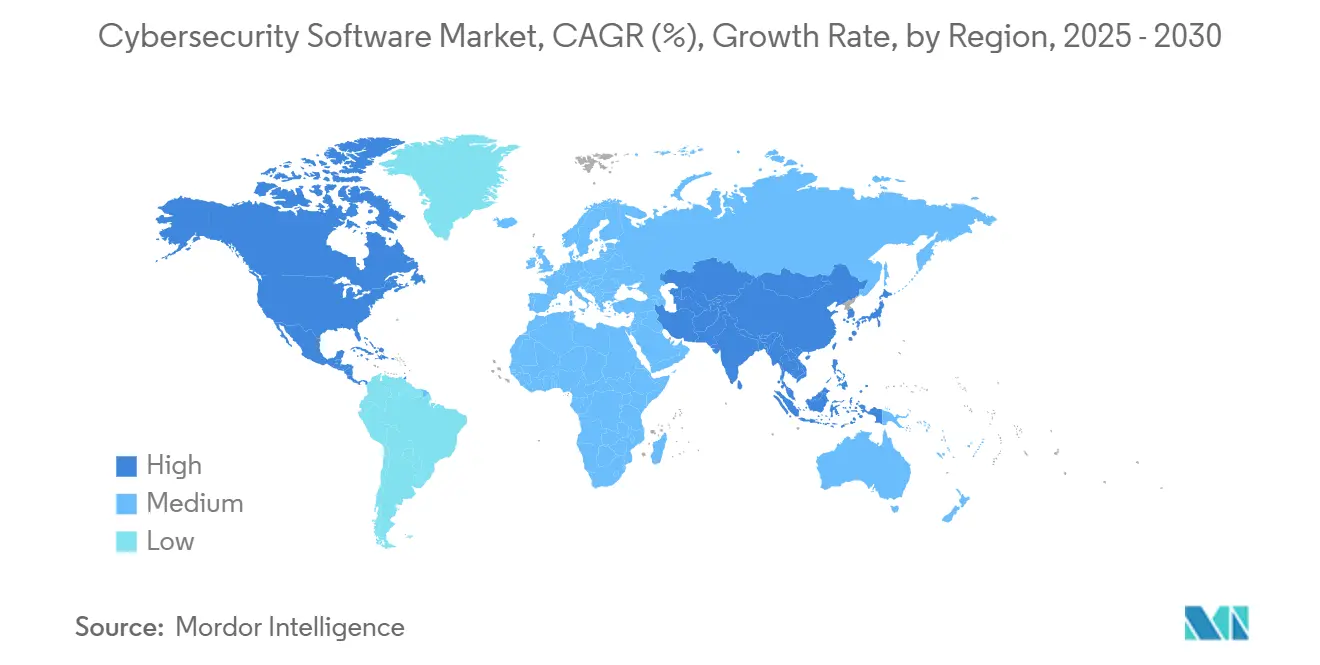
Competitive Landscape
The cybersecurity software market is moderately fragmented but consolidating quickly as platform economics outweigh standalone features. Microsoft, CrowdStrike, and Palo Alto Networks anchor platform strategies that span endpoint, cloud, and network domains. Microsoft’s integrated approach produced USD 20 billion security revenue in 2024. CrowdStrike reports that 64% of its user base adopted five or more modules and reached USD 4.6 billion ARR. Palo Alto Networks continues to integrate AI-powered threat analytics across its Prisma and Cortex suites.
Success factors now extend beyond technology to ecosystem depth, threat-intel sharing, and managed service offerings. Vendors with open APIs and robust marketplace integrations lower switching costs and accelerate adoption. Conversely, those unable to articulate clear ROI risk exclusion from increasingly data-driven procurement evaluations.
Cybersecurity Software Industry Leaders
-
IBM
-
Microsoft
-
Cisco
-
Check Point
-
Broadcom (Symantec)
- *Disclaimer: Major Players sorted in no particular order
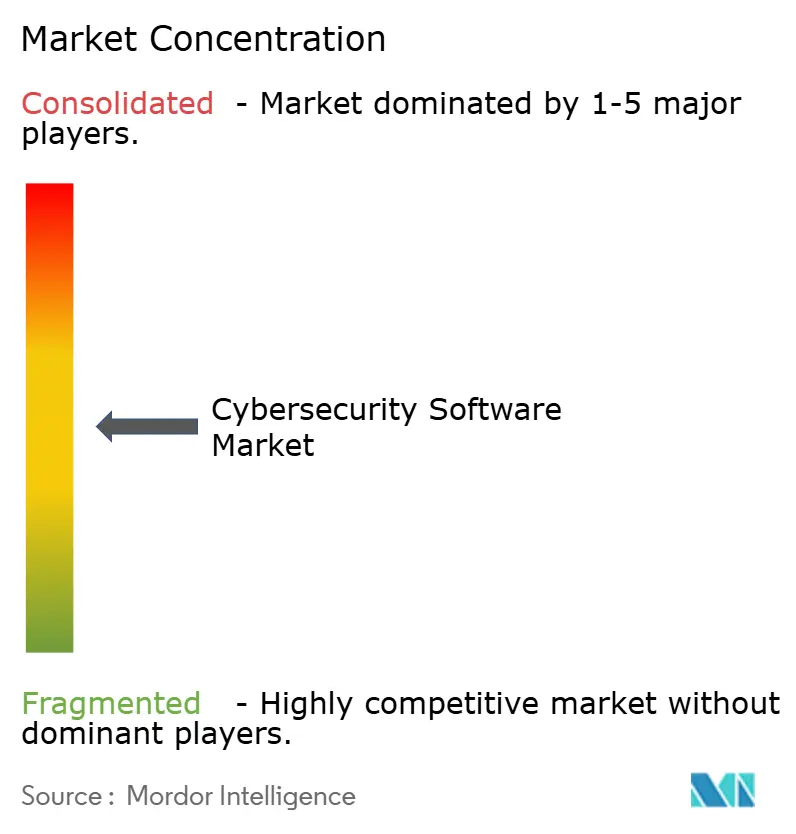
Recent Industry Developments
- June 2025: Tenable acquired AI startup Apex Security to add AI system security to the Tenable One platform, enabling partners to monitor enterprise AI deployments.
- May 2025: Zscaler agreed to acquire Red Canary to enhance AI-powered security operations by integrating MDR expertise with 500 billion daily transactions.
- May 2025: Japan’s KDDI and NEC formed a joint venture to protect critical infrastructure and supply chains, challenging incumbent providers.
- April 2025: Palo Alto Networks purchased ProtectAI to bolster AI security capabilities and defend machine-learning pipeline.
Global Cybersecurity Software Market Report Scope
The cybersecurity software market is defined based on the revenues generated from the software used in various end-user industries across the globe. The analysis is based on the market insights captured through secondary research and the primaries. The market also covers the major factors impacting its growth in terms of drivers and restraints. The study tracks the key market parameters, underlying growth influencers, and major vendors operating in the industry, which support the market estimations and growth rates over the forecast period.
The cybersecurity software market is segmented by offering (software [application security, cloud security, data security, identity and access management, infrastructure protection, integrated risk management, network security equipment, endpoint security, other solutions]), deployment (cloud, on-premises), end-user (BFSI, healthcare, manufacturing, government and defense, and it and telecommunication, other end-users), and geography (North America, Europe, Asia Pacific, Latin America, and Middle East and Africa). The market sizes and forecasts are provided in terms of value (USD) for all the above segments.
| Application Security |
| Cloud Security |
| Data Security |
| Identity and Access Management |
| Infrastructure / Network Protection |
| Others |
| On-premises |
| Cloud |
| BFSI |
| Healthcare |
| Manufacturing |
| Government and Defense |
| IT and Telecommunications |
| Others |
| Large Enterprises |
| Small and Medium Enterprises (SMEs) |
| North America | United States | |
| Canada | ||
| Mexico | ||
| South America | Brazil | |
| Argentina | ||
| Rest of South America | ||
| Europe | Germany | |
| United Kingdom | ||
| France | ||
| Italy | ||
| Spain | ||
| Rest of Europe | ||
| Asia-Pacific | China | |
| Japan | ||
| India | ||
| South Korea | ||
| Australia | ||
| Southeast Asia | ||
| Rest of Asia-Pacific | ||
| Middle East and Africa | Middle East | Saudi Arabia |
| United Arab Emirates | ||
| Turkey | ||
| Rest of Middle East | ||
| Africa | South Africa | |
| Nigeria | ||
| Egypt | ||
| Rest of Africa | ||
| By Offering | Application Security | ||
| Cloud Security | |||
| Data Security | |||
| Identity and Access Management | |||
| Infrastructure / Network Protection | |||
| Others | |||
| By Deployment Model | On-premises | ||
| Cloud | |||
| By End-User Vertical | BFSI | ||
| Healthcare | |||
| Manufacturing | |||
| Government and Defense | |||
| IT and Telecommunications | |||
| Others | |||
| By Organization Size | Large Enterprises | ||
| Small and Medium Enterprises (SMEs) | |||
| By Geography | North America | United States | |
| Canada | |||
| Mexico | |||
| South America | Brazil | ||
| Argentina | |||
| Rest of South America | |||
| Europe | Germany | ||
| United Kingdom | |||
| France | |||
| Italy | |||
| Spain | |||
| Rest of Europe | |||
| Asia-Pacific | China | ||
| Japan | |||
| India | |||
| South Korea | |||
| Australia | |||
| Southeast Asia | |||
| Rest of Asia-Pacific | |||
| Middle East and Africa | Middle East | Saudi Arabia | |
| United Arab Emirates | |||
| Turkey | |||
| Rest of Middle East | |||
| Africa | South Africa | ||
| Nigeria | |||
| Egypt | |||
| Rest of Africa | |||
Key Questions Answered in the Report
What is the current size of the cybersecurity software market?
The cybersecurity software market reached USD 141.13 billion in 2025 and is forecast to hit USD 265.99 billion by 2030 at a 13.51% CAGR.
Which segment is growing the fastest within the cybersecurity software market?
Cloud security offerings are projected to expand at a 14.9% CAGR through 2030, the fastest among all product categories.
Why is healthcare seeing rapid cybersecurity spending growth?
Healthcare breach costs now exceed USD 9.77 million on average, prompting the vertical to invest aggressively and achieve a leading 13.7% CAGR through 2030.
How is zero-trust architecture influencing market demand?
With 81% of organizations planning zero-trust adoption by 2026, buyers increasingly favor integrated platforms that enforce identity-centric policies across cloud and on-premises resources.
Page last updated on:
